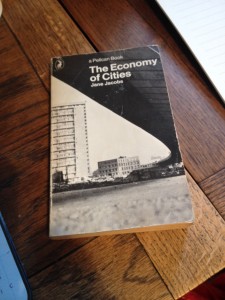In re-reading (after many years) Jane Jacobs’ [amazon_link id=”039470584X” target=”_blank” ]The Economy of Cities[/amazon_link], I’m forcibly struck by the echoes between her work on urban diversity and the recent work on complexity by Ricardo Hausmann and Cesar Hidalgo in their [amazon_link id=”0262525429″ target=”_blank” ]Atlas of Economic Complexity[/amazon_link]. Although their focus is the national level, cities drive national economies (as Jacobs so convincingly argues). What she does so magnificently is describe the process at the more disaggregated level.
[amazon_image id=”B000TOPA52″ link=”true” target=”_blank” size=”medium” ](The Economy of Cities) BY (Jacobs, Jane) on 1970 (Paperback)[/amazon_image] [amazon_image id=”0262525429″ link=”true” target=”_blank” size=”medium” ]The Atlas of Economic Complexity: Mapping Paths to Prosperity[/amazon_image]
Also striking is her argument about innovation as a process of branching out of new activities from old ones, in ever more intricate trees. The process is not driven by solving problems or meeting unsatisfied demands by consumers, she argues, but rather is producer-driven. “The new goods and service being added may be irrelevant to what customers of the older work want.” Or perhaps even detrimental to those customers. In one of her examples, Ida Rosenthal invented the brassiere, and in doing so abandoned the customers of her older dress-making business. Software developers are always annoying their customers, and we’ve got used to that, but I hadn’t really thought about the same phenomenon in other areas of the economy.
I also picked up recently a fabulous catalogue from a 2001 Tate Modern exhibition, [amazon_link id=”1854373447″ target=”_blank” ]Century City: Art and Culture in the Modern Metropolis[/amazon_link]. It has some great essays, including Sharon Zukin on ‘How to create a culture capital: reflections on urban markets and places’: “The business of cities today is to construct a place around culture markets….. A cultural quarter is very much like a regional industrial district.” The difference being that cultural districts have to bring their consumers to them rather than taking goods to the consumers, with consequences for the built environment and amenities.
[amazon_image id=”1854373447″ link=”true” target=”_blank” size=”medium” ]Century City: Art and Culture in the Modern Metropolis (Art Catalogue)[/amazon_image]
There’s a new urbanism exhibition at the Barbican that looks interesting: Constructing Worlds: Photography and Architecture in the Modern Age.
PS I forgot to mention a recent book, [amazon_link id=”0691157812″ target=”_blank” ]The Atlas of Cities[/amazon_link] edited by Paul Knox, a beautiful object as well as stuffed with fascinating material.
[amazon_image id=”0691157812″ link=”true” target=”_blank” size=”medium” ]Atlas of Cities[/amazon_image]


